Brick and Block
Investing in Ourselves
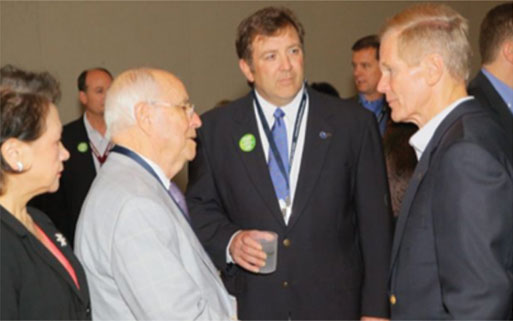
Shown is Major Ogilvie (center) introducing Sen. Bill Nelson (right) to Charles Newsome with Johnson Concrete Co. on The Hill in 2012.
A joint effort between the MCAA and the NCMA will result in more research, increased education and much-needed promotion.
Gather a group of mason contractors and masonry industry professionals in the same room, and you’ll hear talk of the same issues time and again. “We need to do a better job of promoting masonry. We need better masonry education. We need the ability to conduct more research to prove the worth and benefits of masonry.”??
Although well-intended companies contribute funds in support of masonry, but the picture – and the need – is much bigger. Relying on a slice of the pie to support the whole is not working. Existing grants and funds are commendable, but those monies aren’t consistent enough to create a real push for the industry.
So, finally, the masonry industry is making a conscious decision to invest in ourselves, in order to create a future for and a continuation of the industry – and it’s about time.
The players and the plan
The idea for a check-off program was born back in 2009, when the Mason Contractors Association of America (MCAA) and the National Concrete Manufacturers Association (NCMA) put their heads together at a meeting in Phoenix, Ariz.
The effort would consist of writing a bill, introducing it before Congress, garnering support and getting it passed, and – eventually – putting into place a concrete masonry unit (CMU) Check-Off Program for all concrete masonry producers.
Concrete masonry producers would donate one penny per block sold into a fund that the masonry industry would use toward education, research and marketing – all of which are desperately needed.
“The effort would allow the concrete masonry industry to fund promotion of our product. No lobbying, etc., would be funded with this money,” says Major Ogilvie, national chairman of the National Concrete Masonry Check-Off Program (http://cmucheckoff.com), NCMA member, and GM for USA Family of Co.s (Block and Ready Mix USA). “The check-off program is its own entity and will have its own board with the final say on the investment of dollars. The board will have members from five regions to insure consistent and thorough representation of all members.”
The breakdown of Check-Off Program funds would be as follows: a maximum of 10 percent for administration, with the remaining 90 percent being in invested in local, state, regional and national opportunities – in that priority.
Once Congress approves the proposed concrete masonry industry’s program, all U.S. concrete producers will vote a simple majority to establish the program for our industry. Each producer will be assessed $.01 per CMU produced.
A third-party entity accountable to the board will collect the funds, with the board managing and investing the funds collected. Ogilvie estimates the amount to be $8 million to $10 million annually, based on the current estimates of volume. A group of nominees will be slated from various geographical regions of the country, and the secretary of the proposed agency – The Department of Commerce – overseeing the program will appoint 21 voting board members from the slated group recommended by the industry-submitted nominees.
Can it work?
Absolutely, it can work. You’re probably familiar with similar campaigns from the beef (It’s What’s for Dinner), milk (Got Milk?), propane, wood and other industries. This would be no different as a mandatory donation toward a fund to promote the product is sure to bring success. In fact, the Canadian Concrete Masonry Producers Association already has seen success with a program similar to a Check-Off Program that began in 2004.
Although the NCMA has had a voluntary donation program in place since 1981, no consistent program ever has existed. In order to adequately fund research projects, educational efforts and promotional/marketing campaigns, a consistent stream of revenue is needed.
For example, Ogilvie says the NCMA once wanted to conduct a study to compare concrete masonry with other systems, but it simply wasn’t affordable at $275,000. The Check-Off Program would make such a study possible. This would arm our industry with researched, well-documented information to prove that masonry systems are the best choice.
“There’s a lot of low-hanging fruit out there we could capitalize on,” says Ogilvie. “Designers aren’t familiar with how to design with our products. Our products would have a presence, and people would feel more comfortable. We need to promote important values, like wind and fire resistance, sustainability and life-cycle costs.”
One obvious use of the money might be to contribute funding toward incorporating masonry into Building Information Modeling software. This is another current effort by the masonry industry to promote and bring to the forefront the benefits of designing with masonry. (See “Masonry and BIM: The Next Level” in Masonry Magazine, January 2013, www.masonrymagazine.com.)
| Case Study |
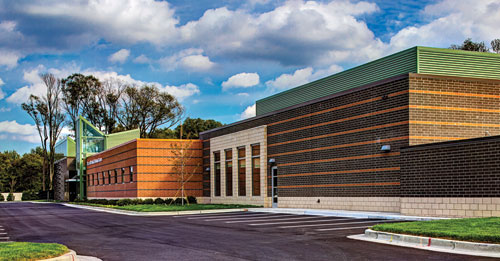
Immersed in the teachings of the Orthodox Jewish Chabad-Lubavitch movement, the foundation of the Harry and Wanda Zekelman boarding school in Oak Park, Mich., is steeped in cultural values. The design of the buildings themselves is fresh and modern – an update on the conventional boarding school look that still accommodates centuries-old traditions. The four-acre campus, which houses up to 180 middle- and high-school boys, includes a 25,000-square-foot school building and a 20,000-square-foot, two-story dormitory.
Varying masonry textures and glass visually segment the long school building into sections. Most prominent is the west end, where the dual study halls are raised an extra half-story into transoms that flood the interior space with daylight. On the outside, dark gray CalStar bricks are arranged in a Flemish bond pattern: Utility bricks are stacked lengthwise and interrupted by a brick placed sideways and corbeled out two inches, resulting in an eye-catching, texturized appearance. On the opposite end of the school building, CalStar bricks, once again, define spaces. Surrounding the square windows of the classrooms are repeating horizontal stripes consisting of five rows of tangerine bricks and one row of gray; abutting that is the lunchroom, where the pattern is reversed with wider swaths of gray bricks and single rows of tangerine. Planning ahead, the classroom area of the building can accommodate a future second story; the glass tower in the center, also the location of the public entrance, eventually will provide a central staircase.
Brick construction was a vital element of the architect’s vision, and the selection of CalStar Products, at an up-to-20-percent lower cost, helped ensure that vision could be realized. “We knew we wanted a masonry building, but [the budget] couldn’t accommodate a masonry building,” says project architect Mike Baer of Neumann/Smith, architect. “CalStar bricks fit into the budget very well, relative to clay brick. They provided a look that has every bit of character as traditional masonry.” The project was completed in August 2012. For more information on CalStar Products, contact Katy Tomasulo at 425.277.9956 or katy@csquaredadvertising.com. |
Where we are
Major Ogilvie first traveled to Washington, D.C., in 2010 to learn if federal money was available for the various initiatives, but says a government handout was not the goal. He then learned about Check-Off Programs and the success that agricultural industry had with them. Today, 23 commodity Check-Off Programs exist in the United States.
After becoming national chairman of the National Concrete Masonry Check-Off Program in fall 2010, he hosted a group of industry leaders in Dallas that December to design a plan of action. Ogilvie has championed the effort to present legislation before Congress that would authorize the creating a concrete masonry Check-Off Program, having hosted industry fly-ins to gain support. Both the Senate and House of Representatives have to accept the plan, and then concrete block producers can vote to approve the program so that it can be implemented.
Ogilvie says that, of the 350 concrete block producers in the country, 96 percent are small, family-owned businesses. In a tough economy, one penny can mean a lot. But he estimates that only 25 percent of the marketing and research needs of the industry are being met. A Check-Off Program is an optimum solution.
| Comparing the Pros and Cons of Exterior Competitors to Brick |
| A video and fact sheets from the Brick Industry Association (BIA) compares bricks with other home exteriors, debunking the common myths about genuine clay brick versus its competitors. With frank pros and cons on the latest in sustainability features, maintenance needs, costs, fire and safety, the package stacks bricks against the top alternatives: vinyl siding, concrete masonry, manufactured stone, fiber cement siding and Exterior Insulation and Finish System (EIFS) – otherwise known as synthetic stucco.
BIA’s booklets include:
Eliminating technical jargon, content areas for each product include major myths, strengths and weaknesses in all areas (aesthetics, initial cost, design flexibility, installation, maintenance and repairs, water management, color fading, fire resistance, wind damage, moisture resistance, insect infestation, damage resistance, environmental concerns, insurance issues); physical properties and construction basics; cross-section diagrams; the differences between brick and each product; sustainability comparisons and product performance. You can link to all fact guides at www.gobrick.com/Resources/Publications/ConsumerProductSheets/tabid/9857/Default.aspx. To learn more, visit the Brick Industry Association (BIA) websites, www.gobrick.com or www.greenbrick.com, or call 703-620-0010. |
Since Ogilvie assembled the team and effort for the Check-Off Program, he, Mark Kemp (MCAA), and other members from both NCMA and MCAA dedicated to this effort spent a great deal of time in 2012 in Washington, D.C., getting in front of Congress members to explain the importance of the National Concrete Masonry Check-Off Program.
And the buzzword when Check-Off Program proponents are before lawmakers is simple: jobs. “The key word is jobs,” says Mark M. Kemp, CEO of Superior Masonry Builders Inc., and vice chair for the MCAA. “It’s about job creation, sustainability and safety. Increased market share will, ultimately, create jobs. Masonry is a labor-intensive system that provides good, quality jobs.
“The Check-Off Program has been one of the main things we are pushing for; it’s our survival,” Kemp continues. “Without it, we won’t be able to compete with other systems. We have always been segmented. We all have ideas, but no one has the money to invest in our future. Precast is killing us, and the wood industry has their program running.”
| A State Perspective |
| Patrick J. McLaughlin, executive director of the Masonry Association of Florida Inc., is fighting the good fight in Florida as the champion behind the Masonry Products Research, Education, and Promotion Act.
Florida has seen success with state-level Check-Off Programs for industries like cattle and citrus. Many national Check-Off acts also are state acts in Florida, like beef, propane and soybeans. With Florida as the largest concrete masonry state in the country, the Masonry Association of Florida Board of Directors decided to develop a statewide Check-Off Program. The act was filed in 2012 with Florida legislation, but was lost in a procedural fight in the House of Representatives. McLaughlin says the Masonry Products Research, Education, and Promotion Act already has been filed again, and he will be visiting legislators around the state to garner support. “We are getting good support, though there is always one or two who might not be on board,” McLaughlin says. “Then, a light bulb goes off in Senator’s mind, when he asks why masonry has to go to the government to ask permission to raise funds. National antitrust laws bar producers from getting together and assessing themselves for common good of the industry, so special permission is needed to allow industry to do this.” McLaughlin makes it clear that producers would not raise the price of a CMU by one penny as masonry is a commodity, and the penny would be shown right on the invoices. “We are playing catch up,” he adds. “Budgets are half to less than half of what they were four years ago for an education program in Florida, and the industry is always behind the eight ball. We need to catch up and get ahead of the cycle. “Most agree that masonry is a strong product,” McLaughlin adds. “Concrete masonry is a 100 percent a Florida product, and it provides safety, strength, energy efficiency and sustainability. We’ve lost ground to wood during the last five or six years. But how will wood buildings work out during the next Florida storm?” Patrick J. McLaughlin can be contacted at pat@floridamasonry.com. |
What’s next?
Kemp says the group had hoped to get the Check-Off Program pushed through Congress during the lame duck session of 2012, having been in Washington, D.C., with others in December to promote the effort. But that did not happen, so 2013 is the year to accomplish the goal.
A trip to D.C. is planned for early-February for more discussions. With a shift in Congressional members, the group behind the Check-Off program is, in some ways, starting all over.
“We will begin process again in the 113th Congress,” Ogilvie says. “We’ll be meeting with Congressmen, explaining our program, and getting their signatures.” He adds that in the 112th Congress, the proposed bill had 56 cosponsors in House of Representatives and 10 cosponsors in Senate, and this was bipartisan support. What have not changed are the cosponsors of the bill, Sen. Bill Nelson (D-FL) and Sen. Roy Blunt, (R-MO).
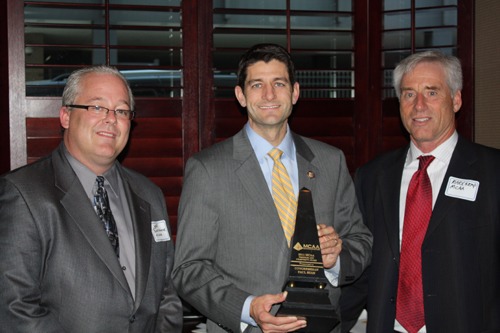
“We need to push it through and get it done this year,” Kemp says. “An extreme effort has been made thus far by the MCAA and the NCMA in the way of writing the bill, lobbying, visits to Washington, and convincing producers.”
Much of the discussion with Congressmen will happen during the MCAA Legislative Conference in May in Washington, D.C., when members of the MCAA and the NCMA will heavily push the Check-Off Program to lawmakers. But this is only part of the effort. In addition to the extensive work that occurs behind the scenes by Major Ogilvie, Mark Kemp, and others, visits will occur throughout the year.
Our industry is determined to create a way to fund education, research and marketing. We are ready to invest in ourselves.
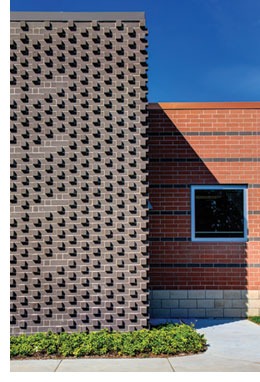 To meet the requirements of the Orthodox Jewish culture, the students are segregated by age in both the school and the dorm. In the dorm, a separate entrance takes the younger boys to their second-floor living area, while the older students reside on the first floor. In the school, this meant designing two mirror-image wings along a lengthy axis, each containing a study hall, four classrooms, and a cafeteria. Each lunchroom has kosher kitchens to separate meat and dairy.
To meet the requirements of the Orthodox Jewish culture, the students are segregated by age in both the school and the dorm. In the dorm, a separate entrance takes the younger boys to their second-floor living area, while the older students reside on the first floor. In the school, this meant designing two mirror-image wings along a lengthy axis, each containing a study hall, four classrooms, and a cafeteria. Each lunchroom has kosher kitchens to separate meat and dairy.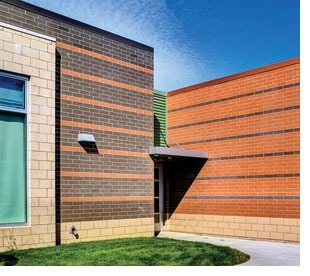 The masonry theme carries over to the dormitory in the rear of the property, where gray CalStar bricks laid in a Flemish bond distinguish the area of the building holding the mikvah, a ritual bathing pool.
The masonry theme carries over to the dormitory in the rear of the property, where gray CalStar bricks laid in a Flemish bond distinguish the area of the building holding the mikvah, a ritual bathing pool.